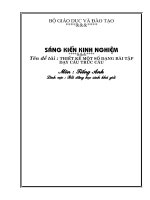Tài liệu bồi dưỡng chuyên đề Tiếng Anh tại Trường THPT ...
Bạn đang xem bản rút gọn của tài liệu. Xem và tải ngay bản đầy đủ của tài liệu tại đây (364 KB, 19 trang )
<span class='text_page_counter'>(1)</span><div class='page_container' data-page=1>
<b>Teaching with </b>
<b>the Revised </b>
<b>Bloom’sTaxonomy</b>
</div>
<span class='text_page_counter'>(2)</span><div class='page_container' data-page=2>
<b>Taxonomy = Classification</b>
<b>Classification of thinking</b>
<b>Six levels </b>
</div>
<span class='text_page_counter'>(3)</span><div class='page_container' data-page=3>
<b>Evaluation</b>
<b>Synthesis</b>
<b>Analysis</b>
<b>Application</b>
<b>Comprehension</b>
<b>Knowledge</b>
<b>Creating</b>
<b>Evaluating</b>
<b>Analyzing</b>
<b>Applying</b>
<b>Understanding</b>
<b>Remembering</b>
<i><b>Original</b></i> <i><b>Revised</b></i>
</div>
<span class='text_page_counter'>(4)</span><div class='page_container' data-page=4>
<b>Remembering</b>
The learner is able to recall, restate and
remember learned information
– <sub>Describing</sub>
– Finding
– Identifying
– <sub>Listing</sub>
– <sub>Retrieving</sub>
– Naming
– Locating
– <sub>Recognizing</sub>
</div>
<span class='text_page_counter'>(5)</span><div class='page_container' data-page=5>
<b>Understanding</b>
Student grasps meaning of information
by interpreting and translating
what has been learned
– <sub>Classifying</sub>
– Comparing
– Exemplifying
– <sub>Explaining</sub>
– <sub>Inferring</sub>
– Interpreting
– Paraphrasing
– <sub>Summarizing</sub>
</div>
<span class='text_page_counter'>(6)</span><div class='page_container' data-page=6>
<b>Applying</b>
Student makes use of information in a context
different from the one in which it was learned
– <sub>Implementing</sub>
– Carrying out
– <sub>Using</sub>
– Executing
<i> Can students use the information in </i>
<i>another familiar situation?</i>
</div>
<span class='text_page_counter'>(7)</span><div class='page_container' data-page=7>
<b>Analyzing</b>
Student breaks learned information into
its parts to best understand that information
– <sub>Attributing </sub>
– Comparing
– Deconstructing
– <sub>Finding</sub>
– <sub>Integrating </sub>
– Organizing
– Outlining
– <sub>Structuring</sub>
</div>
<span class='text_page_counter'>(8)</span><div class='page_container' data-page=8>
<b>Evaluating</b>
Student makes decisions based on in-depth
reflection, criticism and assessment
– <sub>Checking</sub>
– Critiquing
– Detecting
– <sub>Experimenting</sub>
– <sub>Hypothesising</sub>
– Judging
– Monitoring
– <sub>Testing</sub>
<i>Can students justify a decision or </i>
</div>
<span class='text_page_counter'>(9)</span><div class='page_container' data-page=9>
<b>Creating</b>
Student creates new ideas and information
using what previously has been learned
– <sub>Constructing</sub>
– Designing
– Devising
– <sub>Inventing</sub>
– <sub>Making </sub>
– Planning
– Producing
</div>
<span class='text_page_counter'>(10)</span><div class='page_container' data-page=10>
<b>Questioning . . .</b>
• <sub>Higher level questions require complex </sub>
application, analysis, evaluation or creation
skills
• <sub>Higher level questions</sub>
– <sub>Encourage students to think more deeply and </sub>
critically
– <sub>Facilitate problem solving</sub>
– <sub>Encourage discussions</sub>
– <sub>Stimulate students to seek information on their </sub>
own
University of Illinois (2006)
</div>
<span class='text_page_counter'>(11)</span><div class='page_container' data-page=11>
<b>“Remembering” stems</b>
What happened after...?
How many...?
What is...?
Who was it that...?
Name ...
Find the definition of…
Describe what happened after…
Who spoke to...?
Which is true or false...?
</div>
<span class='text_page_counter'>(12)</span><div class='page_container' data-page=12>
<b>“Understanding” stems</b>
Explain why…
Write in your own words…
How would you explain…?
Write a brief outline...
What do you think could have happened next...?
Who do you think...?
What was the main idea...?
Clarify…
Illustrate…
</div>
<span class='text_page_counter'>(13)</span><div class='page_container' data-page=13>
<b>“Applying” stems</b>
Explain another instance where…
Group by characteristics such as…
Which factors would you change if…?
What questions would you ask of…?
From the information given, develop a set of
instructions about…
</div>
<span class='text_page_counter'>(14)</span><div class='page_container' data-page=14>
<b>“Analyzing” stems</b>
Which events could not have happened?
If. ..happened, what might the ending have been?
How is...similar to...?
What do you see as other possible outcomes?
Why did...changes occur?
Explain what must have happened when...
What are some or the problems of...?
Distinguish between...
What were some of the motives behind..?
What was the turning point?
What was the problem with...?
</div>
<span class='text_page_counter'>(15)</span><div class='page_container' data-page=15>
<b>“Evaluating” stems</b>
Judge the value of... What do you think about...?
Defend your position about...
Do you think...is a good or bad thing?
How would you have handled...?
What changes to… would you recommend?
Do you believe...? How would you feel if...?
How effective are...?
What are the consequences...?
What influence will....have on our lives?
What are the pros and cons of....?
Why is....of value?
What are the alternatives?
</div>
<span class='text_page_counter'>(16)</span><div class='page_container' data-page=16>
<b>“Creating” stems</b>
Design a...to...
Devise a possible solution to...
If you had access to all resources, how would you
deal with...?
Devise your own way to...
What would happen if ...?
How many ways can you...?
Create new and unusual uses for...
Develop a proposal which would...
</div>
<span class='text_page_counter'>(17)</span><div class='page_container' data-page=17>
<b>Summary</b>
<b>Bloom’s revised taxonomy</b>
• <sub>Systematic process of thinking & learning</sub>
• <sub>Assists assessment efforts with easy-to-use </sub>
format
• <sub>Visual representation of alignment between goals </sub>
& objectives with standards, activities, &
outcomes
• <sub>Helps form challenging questions to help </sub>
students gain knowledge & critical thinking skills
• <sub>Assists in development of goals, objectives, & </sub>
</div>
<span class='text_page_counter'>(18)</span><div class='page_container' data-page=18>
Let’s Practice!
</div>
<span class='text_page_counter'>(19)</span><div class='page_container' data-page=19>
<b>References and Resources</b>
Cruz, E. (2003). Bloom's revised taxonomy. In B. Hoffman (Ed.), <i>Encyclopedia of Educational </i>
<i>Technology.</i>
Dalton, J. & Smith, D. (1986) <i>Extending children’s special abilities: Strategies for primary classrooms.</i>
/>
Ferguson, C. (2002). Using the revised Bloom’s Taxonomy to plan and deliver team-taught, integrated,
thematic units. <i>Theory into Practice,</i> <i>41</i>(4), 239-244.
Forehand, M. (2008). Bloom’s Taxonomy: From emerging perspectives on learning, teaching and
technology. />
Mager, R. E. (1997). <i>Making instruction work or skillbloomers: A step-by-step guide to designing and </i>
<i>developing instruction that works,</i> (2nd ed.). Atlanta, GA: The Center for Effective Performance,
Inc.
Mager, R. E. (1997). <i>Preparing instructional objectives: A critical tool in the development of effective </i>
<i>instruction,</i> (3rd ed.). Atlanta, GA: The Center for Effective Performance, Inc.
Pohl, Michael. (2000). <i>Learning to think, thinking to learn: Models and strategies to develop a </i>
<i>classroom culture of thinking</i>. Cheltenham, Vic.: Hawker Brownlow.
Tarlinton (2003). <i>Bloom’s revised taxonomy.</i>
</div>
<!--links-->
tài liệu bồi dưỡng chuyên môn
- 4
- 679
- 1








